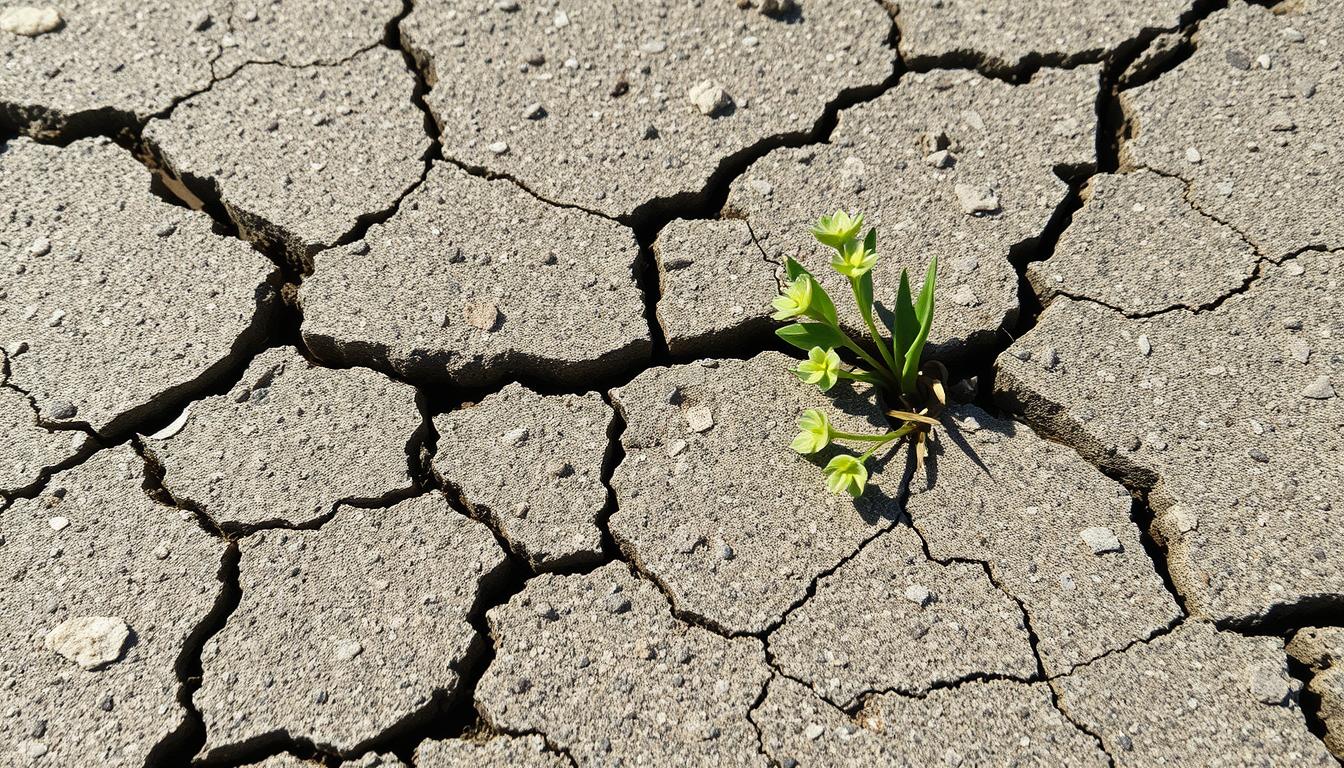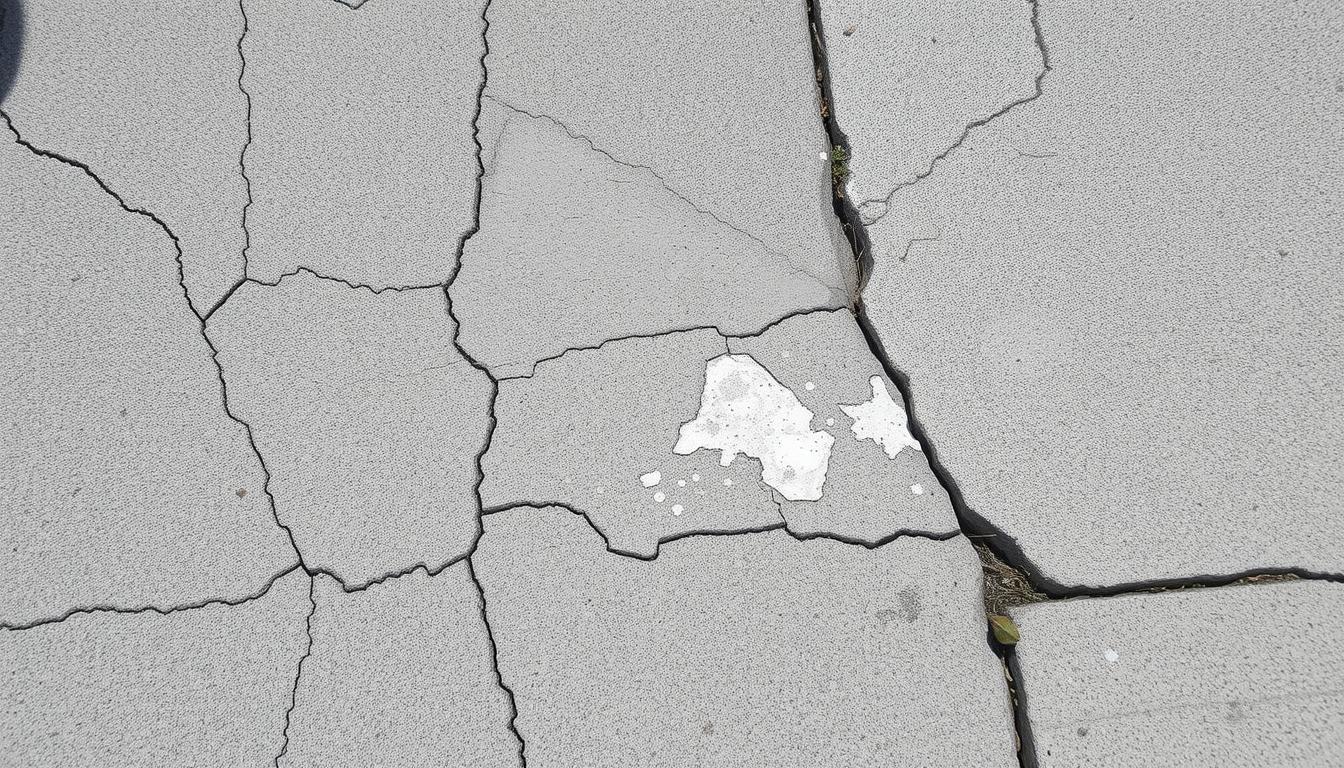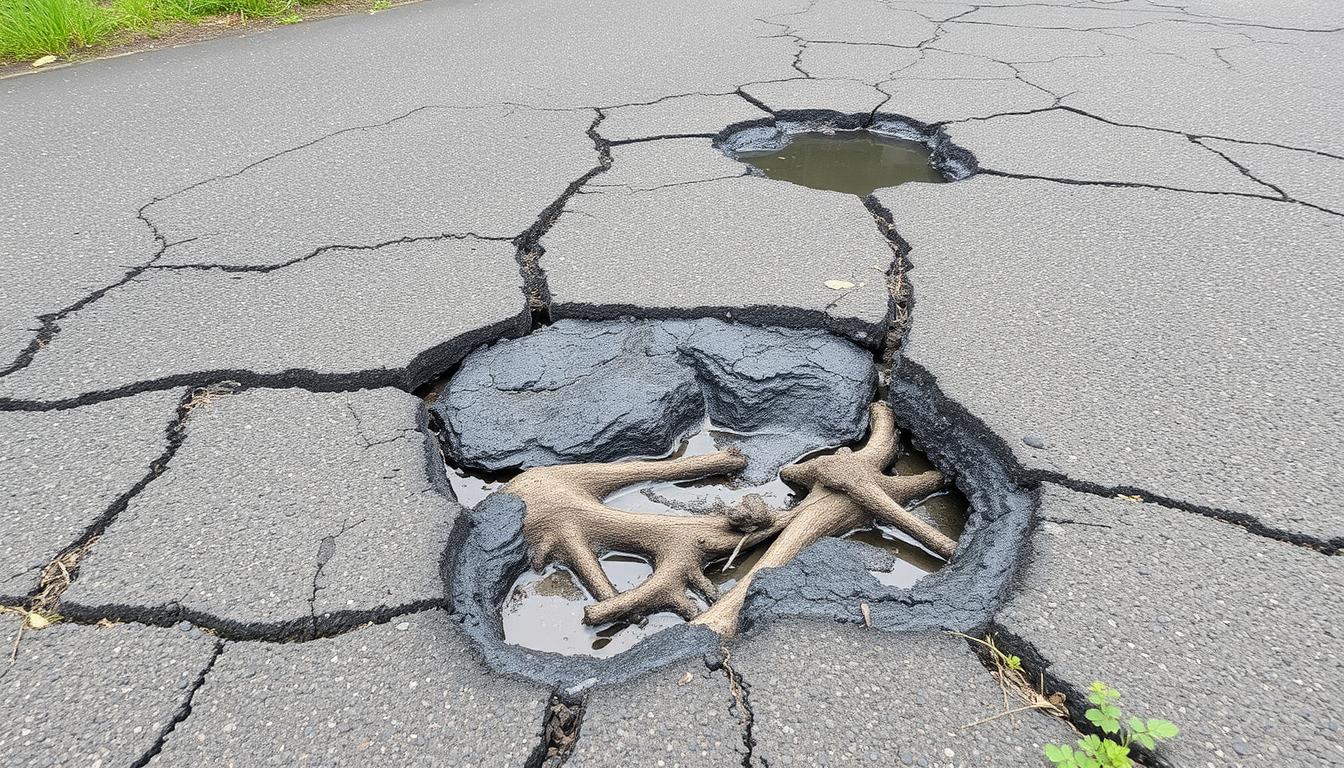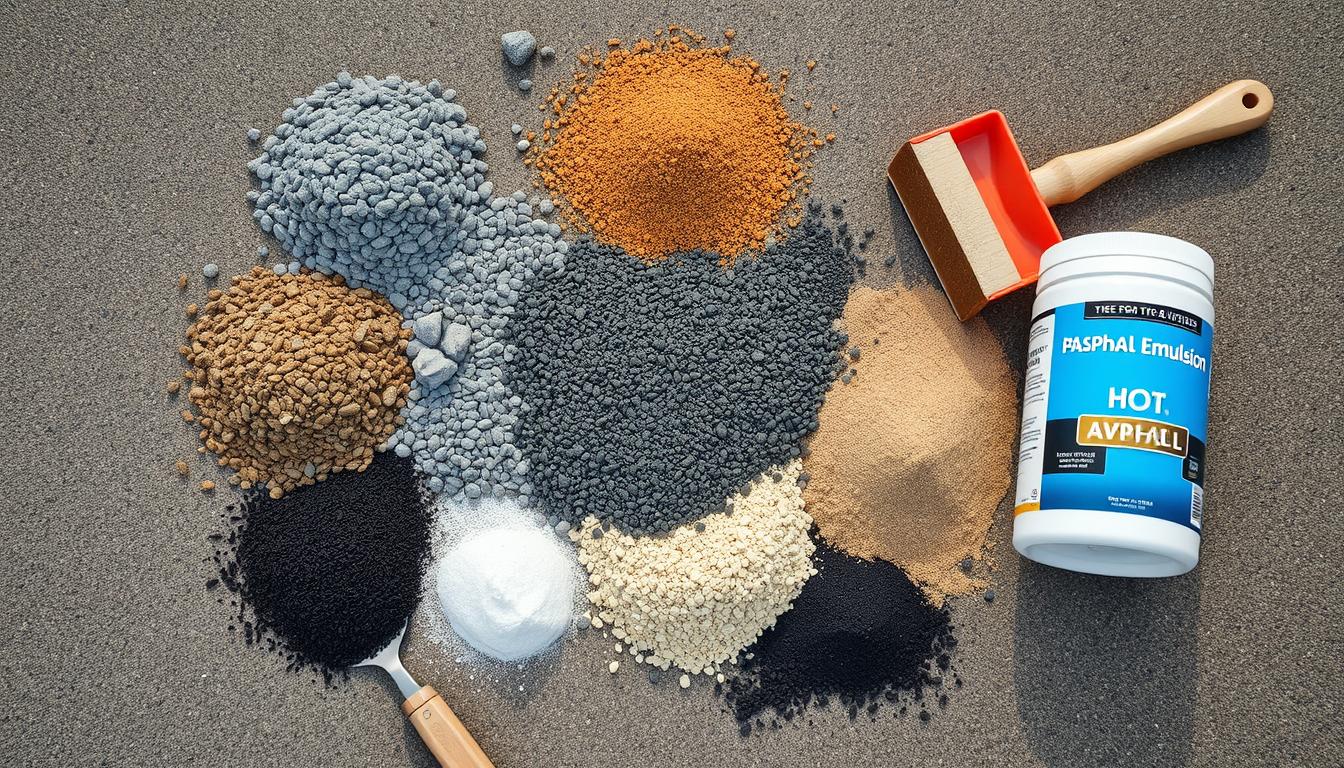Ever wondered What Are The Common Issues That Require Concrete Repair? Concrete is tough but faces many challenges. Things like the environment, wrong installation, and aging can cause problems. It’s important for property owners to spot these issues early.
This helps keep the concrete looking good and strong. Knowing about these issues is important.
Common problems include cracking, scaling, discoloration, and settlement. Cracking is the biggest issue, making up 80% of damage. Even small hairline cracks can grow into big problems if ignored.
Scaling, caused by de-icing salts, affects 30% of outdoor surfaces. Discoloration impacts 10-15% of new concrete, often from bad mixing. Settlement problems also affect 10-15% of buildings, making early action necessary.
Key Takeaways
- Concrete cracking is the most prevalent problem, constituting 80% of all damages.
- Scaling affects 30% of exterior surfaces, predominantly in cold weather regions.
- Efflorescence appears in about 25% of concrete installations, often due to moisture.
- Settlement issues impact 10-15% of buildings, stressing the need for site evaluations.
- Timely maintenance can prevent up to 75% of concrete problems.
Introduction to Concrete Repair Needs
Concrete is a strong material used in many construction projects. But, keeping it in good shape is key. Regular checks and fixes are vital. Without them, structures can quickly fall into disrepair, costing a lot to fix.
Knowing how to maintain concrete helps owners spot problems early. This way, they can avoid expensive fixes later on.
Understanding the Importance of Concrete Maintenance
Keeping concrete surfaces in check can make them last longer and safer. Studies show that 30% to 40% of concrete structures need repair. Poor preparation can lead to up to 60% of these repairs failing early.
Getting the surface right is critical. Rough surfaces can make concrete last up to 25% longer. Making sure the surface is dry before fixing can cut down on failures by up to 20%. Following repair instructions can lead to 90% success, showing how important maintenance is.
Overview of Common Concrete Issues
Concrete problems include cracks, scaling, and discoloration. Cracks happen from temperature changes and bad construction. Scaling comes from too much moisture, and discoloration from poor curing.
Spotting these issues early can prevent major damage. Knowing about these problems helps owners focus on maintenance. This can save a lot of money on repairs over time.
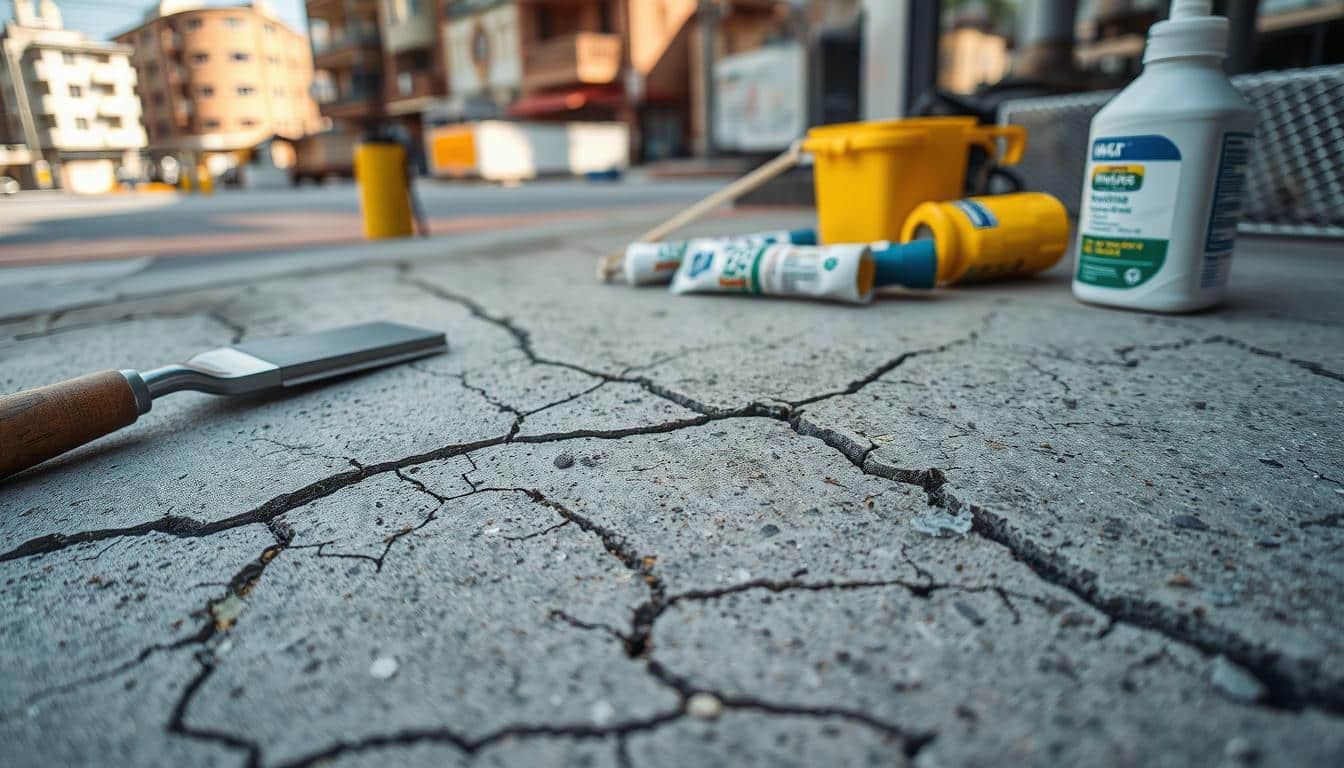
Cracking in Concrete Surfaces
Cracks in concrete worry many people. Knowing why they happen helps find the best ways to fix them. Weather and how the concrete was laid can cause cracks. Fixing them fast is key to keeping your place looking good and safe.
Causes of Concrete Cracking
Many things can cause concrete to crack. Shrinkage, temperature changes, and heavy loads are common culprits. Weather, like freezing and thawing, can make things worse, too. Spotting cracks early is important to fix them right.
Different Types of Cracks
Concrete cracks come in different sizes and types. Small cracks are usually okay, but big ones can be a problem. They can let water in and cause more damage. Knowing the type of crack helps figure out how to fix it.
Repair Options for Cracked Concrete
Fixing concrete cracks depends on their size and type. Small cracks can be sealed with special products. But bigger cracks need something that can stretch and move with the concrete. For serious cases, like epoxy injection, might be needed. Each fix aims to make the concrete strong again and stop more damage.
Scaling and Spalling
Scaling and spalling are common problems that can harm concrete surfaces. Knowing about these issues helps property owners fix them. Scaling happens when concrete flakes off, often because of moisture and freezing. Spalling is a bigger problem, showing that the steel inside the concrete is rusting.
What is Scaling?
Scaling in concrete looks like flaking on the surface. It can happen in up to 20% of outdoor concrete. De-icing salts and moisture are big causes, with salts being responsible for 50% of problems.
Causes of Spalling in Concrete
Spalling comes from rusting rebar due to moisture and chemicals. Not fixing scaling can lead to worse spalling, affecting up to 10% of concrete structures. Quick action is key to stop further damage.
How to Address Scaling and Spalling
To fix spalling, start by chipping away the damaged concrete. Clean the area well, then apply a concrete resurfacer. Sealing the surface helps prevent future scaling. These steps can make concrete last longer and look better.
Potholes and Depressions
Potholes are a big problem for road safety and infrastructure. They often come from water getting in, freezing, and thawing, and soil changes. Spotting potholes early helps avoid dangers and saves money. Knowing the signs of wear can stop more damage.
To manage potholes well, we need to prevent them and fix them right. This approach helps keep our roads safe and in good shape.
Identifying Potholes and Their Causes
Finding potholes means looking for round or oval dips in the road. Weather, like water getting in and freezing, is a big reason they form. In cities, ignoring potholes can make fixing them much more expensive.
Studies show waiting too long can increase costs by 40%. It’s better to fix them early to save money and keep roads safe.
Prevention and Repair Techniques
To stop potholes, we need to keep up with maintenance. Sealing cracks before winter helps a lot. If potholes do show up, we can fix them with asphalt or overlays.
Doing repairs right can make them last up to five years. Regular checks and sealant help keep them in good shape.
Best Practices for Pothole Repair
Good pothole repair starts with careful planning and the right materials. Checking roads every 2 to 3 years, after bad weather, is key. This helps find problems early.
Using quick concrete for repairs means roads can open up again quickly. This is important in busy cities. Fixing one pothole can cost from $50 to $500, depending on where it is and how big it is. So, fixing them fast is important to save money in the long run.
Surface Discoloration
Many things can cause discoloration on concrete. These include the weather, how it was installed, and chemical reactions. Understanding these causes helps keep concrete looking its best.
Low-quality concrete and uneven curing can lead to color issues. Chemical stains from spills can also harm the look of concrete.
Common Causes of Surface Discoloration
Discoloration can be due to weather or the quality of the concrete. In places like Ottawa, extreme weather can damage the concrete’s surface. Freeze-thaw cycles and de-icing salts can cause stains.
Poor mixing and installation can also lead to discoloration. These issues let water and contaminants in, causing marks.
How to Restore Discolored Concrete
To fix discolored concrete, start by cleaning it well. Use pressure washing or special cleaners to remove dirt and stains. Then, apply a concrete stain or dye to even out the color.
This not only improves the look but also helps seal the surface. Sealing protects against moisture and chemicals, keeping the concrete looking good longer.
Preventive Measures for Color Maintenance
To keep concrete looking its best, take preventive steps. Regularly seal the surface to block moisture and chemicals. Clean it often and act fast on spills to prevent stains.
By tackling problems early, you can keep your concrete looking great for a long time.
Uneven Concrete Surfaces
Uneven concrete surfaces can cause many problems. They can look bad and even affect the building’s strength. It’s important to know why they happen.
Soil erosion, not compacting the ground well, and water getting in are big reasons. In places where it freezes and thaws, concrete gets worse faster. Knowing this helps owners take care of their property.

Identifying Causes of Unevenness
Figuring out why the concrete is uneven is the first step to fixing it. Moisture is a big problem, causing about half of all issues. It leads to about a third of the surfaces sinking.
Other reasons include foundation cracks and unevenness from settling differently. Knowing these helps fix the problem right.
Repair Methods for Uneven Concrete
There are quick fixes for uneven concrete. One good one is polyjacking. It uses foam to lift the slab back up.
This method works well for most small problems. Fixing it fast can make the concrete last 50% longer. It’s a smart choice for saving money and time.
Long-Term Solutions to Prevent Future Issues
Fixing uneven surfaces for good means solving the root problems. Better drainage stops water from causing erosion and sinking. Regular checks and upkeep keep the structure strong.
This keeps the property value up. Companies that fix concrete, like those in this service, can create plans to handle these issues well.
Water Damage and Erosion
Water is a big problem for concrete structures. It can cause erosion and weaken them over time. Checking for water damage regularly is key. This helps keep the concrete strong and avoids expensive fixes later.
How Water Affects Concrete Structures
Water damage in concrete often comes from freeze-thaw cycles, which are worse in cold places. Too much moisture can lead to scaling and spalling. This makes the concrete deteriorate faster because of chemical reactions and bad drainage.
This problem affects about 50% of concrete surfaces in areas where de-icing salts are used. Knowing how water affects these structures helps find the right maintenance plans.
Assessing Water Damage
Checking for water damage means looking for signs like discoloration, cracks, or scaling on concrete surfaces. Good inspections find where moisture is getting in and where drainage might be bad. This helps catch problems early, saving money and time.
Effective Repair Techniques for Water Erosion
Fixing water erosion includes using waterproof sealers and improving drainage. Sealers can cut moisture infiltration by over 80%, making concrete last longer. Fixing small problems early can stop up to 75% of future damage.
Options like surface refinishing not only make things look better. They also protect against environmental stressors.
Joint and Crack Sealing
Sealing joints and cracks is key to keeping concrete in good shape. It stops moisture from getting in, which helps prevent damage like cracking and spalling. Regular checks and sealings can make concrete last longer, keeping it safe and working well for years.
Importance of Sealing Joints and Cracks
Concrete can get damaged by freeze-thaw cycles, chemicals, and moisture. These can cause big problems and make repairs more expensive. Using the right sealants can stop these issues, keeping small fixes from turning into big headaches. Good crack sealing blocks water and chemicals, protecting the concrete’s strength.
Types of Sealants
There are many sealants, like flexible joint sealers and rigid crack fillers. The right one depends on the project’s needs, like the crack size and the weather. Each sealant has its own role, helping keep the concrete looking good and lasting longer. Knowing about these options helps pick the best one for each job.
When to Consider Sealing Services
Knowing when to seal concrete is important for upkeep. It’s best to do regular checks, after weather changes, or when you see wear. Early action can prevent big damage and keep the structure safe. For expert help, check out HT Paving and Sealcoating Services, known for top-notch concrete repair.
Tips for Choosing a Concrete Repair Company
Finding the right concrete repair service is key to fixing your structures well and lasting long. Look for a company with valid licenses and a portfolio of past work. Customer feedback can show if a company is reliable and does good work.
Reviews with a 4.5-star rating or higher are a good sign. They show the company is making many people happy with its service.
What to Look for in a Concrete Repair Service
Choose a service with at least five years of experience. This experience means they know how to fix different problems well. Make sure the company is licensed to work in your state.
Clear pricing is important too. It builds trust with clients. Look for certifications from groups like the American Concrete Institute (ACI) for more credibility.
The Advantages of Hiring Professionals
Hiring pros for concrete repair is a smart move. They can make your concrete last 30-40% longer. They use top-notch materials and know-how that makes a big difference.
They pay close attention to details, which means fewer problems later. More than 80% of contractors say using the best materials is key to lasting repairs.
HT Paving and Seal Coating Services: Your Trusted Partner
HT Paving is a top choice for concrete repair. We’re a family business serving the Bay Area and nearby. We’re all about reliable, quality service.
We combine our experience, focus on customer happiness, and follow industry rules. Choosing HT Paving means you’re choosing the best for your repair needs. We promise timely service and thorough preparation for lasting results.
Safe Practices and Concrete Repair
Safety is key in concrete repair because of the heavy tools and materials. Keeping workers safe is important for the project’s success. If concrete is not handled right, accidents can happen, costs can go up, and projects can get delayed.
Having good safety rules makes the work area safer. This lowers the chances of accidents and problems.
Importance of Workplace Safety in Concrete Repair
It’s vital to understand the role of safety in concrete repair. Workers face dangers like lifting heavy things, dealing with harmful substances, and using big machines. Safety training and the right gear, like helmets and gloves, help a lot.
Having clear safety rules also helps create a safe work culture. This benefits everyone involved in the project.
Implementing Safe Measures on Projects
Safe project planning and execution are essential. Keeping the work area organized helps avoid dangers and makes things run smoother. It’s important to check for safety risks before and during the work.
Using methods to stop dust, like wetting down areas, is key to protecting workers’ health. Also, making sure waste is disposed of properly helps avoid accidents. By focusing on these steps, the risk of injuries and project delays goes down a lot.
Conclusion: Ensuring Durability and Quality
In this article, we’ve looked at common concrete problems like cracking, scaling, discoloration, and erosion. These issues can weaken concrete structures if not fixed quickly. Regular upkeep prevents bigger, more expensive repairs, keeping your concrete safe and working well for years.
Recap of Common Issues
Cracked concrete is a big problem, often caused by settling or temperature changes. Spalling happens when moisture gets in and freezes, making the surface weak. Spotting these problems early helps save money and keeps your property in good shape.
Why HT Paving is Your Best Choice for Concrete Repair
HT Paving and Seal Coating Services is a top choice for fixing concrete. We focus on quality and use the best materials. Our team knows how to make your concrete last longer, using special materials for busy areas.
Contact us at (415) 774-6424 to talk about your concrete needs. Find out how HT Paving can help with your concrete services.
